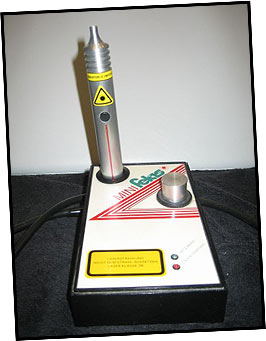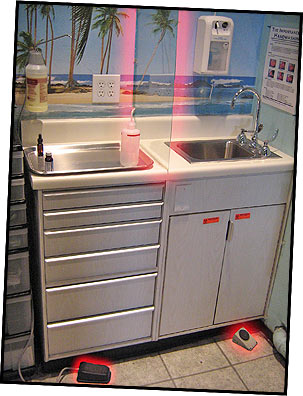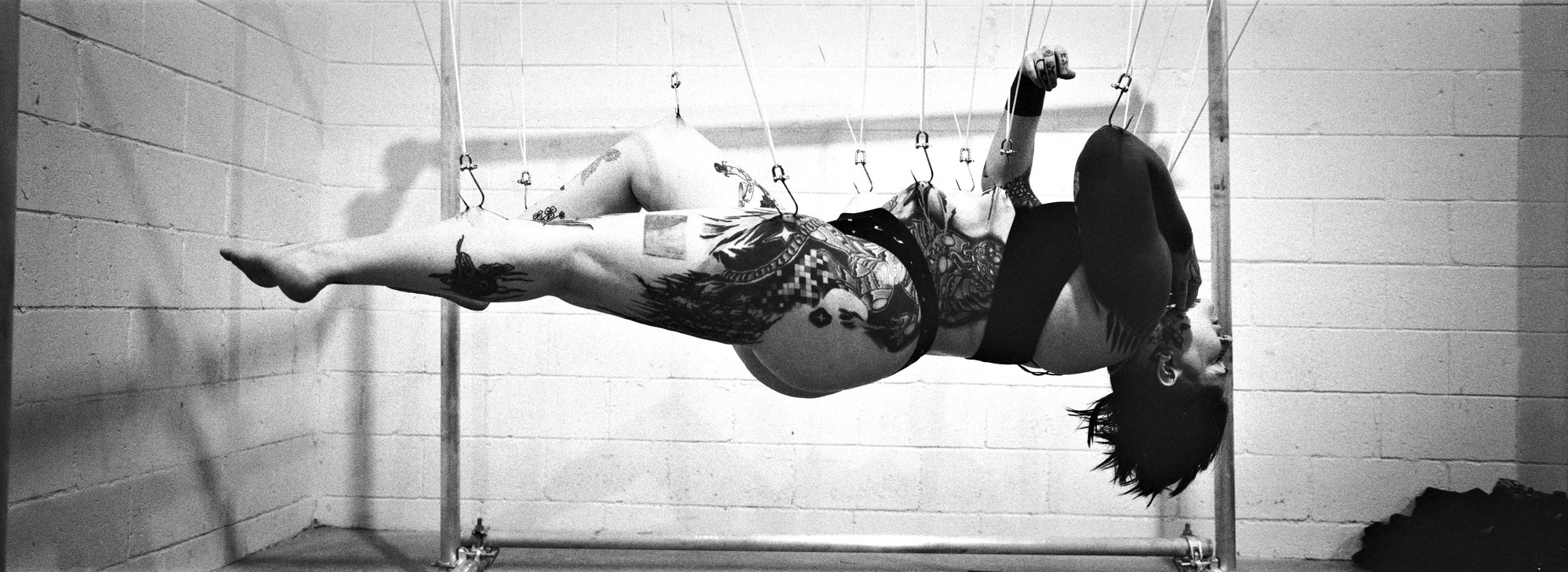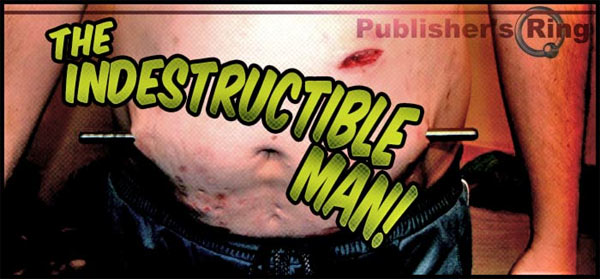Ego Kornus, who runs Kavadi Blog, just did this amazing interview with Carl Vadivella Belle about his many experiences carrying Kavadi. Click through for the interview.
Tag: Interviews
-
An unusual fetish
Written by
-
Piercing Studio Improvements
Written by
I think I mentioned that part of my goal with this education series is to get piercers to think about improving their game in ways they might not have thought of, so this time I want to address the question,
What item(s) do you have in your studio that many other studios may not have? And what are some inexpensive ways that a studio can be inexpensively improved?
Because of education funding cuts, teachers in Canada and the US (and I’m sure around the world) are often forced to buy classroom materials using their own money because the school doesn’t have or isn’t willing to spend the money. Sadly, it’s not uncommon for modern tattoo shops to be the same — because at most shops piercing makes a fraction of what the tattooing makes, it can be very difficult for a piercer to convince the shop owner to spend money on that aspect of the business, and they’re often left trying to find ways to improve it using their own time and money. This time around we’re talking to the folks in the picture below.

Above, L-R: Anders (iam:Alienboy, Anders the Piercing Guy, Brisbane Australia), Dustin Sharrow (iam:Aesthete, Mata Mata, Hamilton, Ontario, Canada), Leo Ziebel (iam:5point, 5pointstudios, Johnston, Iowa, USA), and John Lopez (iam:John Lopez, Slave to the Needle, Seattle, USA).Anders
I have a low frequency laser pen, which is very helpful with small problems such as follicular cysts and small boils, and is also helpful to speed up healing in stubborn piercings [editor’s note: this is called photobiomodulation].

All studios will be different and might need different things, and if the owner doesn’t want to invest in sterilization equipment, most equipment can be rented or leased for a small monthly cost. This means less initial cash outlay for top-quality equipment, and renting and leasing is usually fully tax-deductible.
Dustin Sharrow
At my old shop, where I worked for nearly four years, I had the owner install an air-conditioning vent in my room because it would get very hot in the summertime, and people would pass out. It actually helped. It’s not rocket science, but if you approach the procedure from the point of view of the client, you start to notice things you normally otherwise wouldn’t. For example, at the old shop, there were bright plastic fridge-magnet letters that spelled RELAX inside an overhead light that only the client could see. It was a surprise that everybody, nearly without exception, commented on. It was a great diversion.
In my new piercing room at the new shop, I am fortunate to have a huge wall of glass block that allows natural daylight in. Natural daylight is so much better than fluorescent lighting. I had a half-wall shelf built the entire length of that one wall (in front of the glass block window), and on it I’ve put several plants. Plants are proven to calm people down. Even if you don’t have natural daylight (windows) in your room, I think it would be acceptable to use fake plants! With this new shop, I’ve purposely stayed away from any chrome or polished steel or white walls, except in the sterilization areas. The result is more akin to a spa than a tattoo shop, and is much more inviting and less clinical than a dental office would be (the common association with ‘clean’ shops).
Leo Ziebel
For starters, you can sterilize your gloves. I have no problem with piercers who don’t but I choose to. Again, it’s all about reducing the chance factor for problems. I use presterilized Safeskin nitrile gloves but before I was able to buy those I would make glove packs and sterilize them myself in our autoclave (you do have an autoclave don’t you?). Ron Garza Wrote a good article for The Point that illustrates how you can make your own glove packs if you like. It’s from issue 33 and you can view it at The APP website.
Unfortanately, most things a piercer can do to step up their game can be costly. The situation I find a lot of piercers in is the shop where the owner either doesn’t care or doesn’t want to improve their standards of safe piercing. This can be a very frustruating situation that I have found myself in more than once in my career. Some people just don’t get it and frankly they don’t want to. All they think is “why in god’s name would I spend 8 dollars on something that I can get for 27 cents?” The best way I found to change this was to get my clients who cared to pay up front for nicer jewelry and make small orders to fill their requests. It was slow going and very tiring but over time people started asking for it. It’s really all about how you feel about it. If you are genuinely stoked about something, you’re clients will see that and they will want it too.
John Lopez
The most obvious things that can make drastic improvements are hands-free sinks and soap dispensers. For $135 (less for more units), Sky Renfro will send you a Step-Flow unit which turns ANY sink into a hands-free one. In the scheme of things, this single upgrade can prevent more disease transmission than any other. In conjunction with hands-free Technicare dispensers and other ideas Ill share in a moment, the possibility of spreading micro-organisms around the shop can be reduced even further. Of course this is assuming that hands are being washed correctly and at the appropriate times.
Another great improvement which really costs very little is creating barriers between hand sinks and work areas, and between work areas and contaminated areas. Having clearly defined areas is a key concept, but actual barriers makes things clear to customers as well as guest artists and counter staff.

Barriers can be created with any non-porous material. Above is the piercing set-up area at Slave to the Needle. This single barrier allows us to wash our hands without worrying about splashing potentially contaminated water onto our set-up area. Theres also a hands-free Technicare dispenser and a Step-flow unit to make the sink completely hands-free.
Another, even cheaper thing to consider is simply removing useless, dust gathering items from walls, shelves and counter areas. While nice artwork and other decorations can help provide atmosphere and make a shop interesting, theres really no excuse for clutter and dust-bunnies. Do you really need a hairy shrunken head over the piercing bed? Or forty-five action figures collecting dust on a shelf somewhere?
And no matter who you are or where you work, theres always room for improvement. Sometimes it costs a little money and sometimes it just takes a little energy.
-
Is Body Jewelry Quality Important?
Written by
This is a new section that I’m adding to ModBlog in which we talk to some of the best artists around the world about the nuances of the business of being not just good at what you do, but great. In this first column, we’ll be talking about jewelry — does it really make a difference if you’re using generic “316LVM” versus something that’s “ASTM-spec”? Is titanium really better? Is threading important? What if someone brings in their own jewelry?
I thought this would be a good one to start with, given the recent example of the kid who thought chain links would make acceptable jewelry!
In today’s column, commentary comes from (shown left to right below), Patrick Bartholomew (a mostly retired piercing pioneer who you may know from the London Piercing Clinic, and can be found at iam:PatrickB), Tom Brazda (iam:TomBrazda, TomBrazda.com, former owner and head piercer of Stainless Studios, now doing research and development into new body modification technologies and aftercare at BodyArt Pro), “Moddoctor” (iam:Moddoctor (a practising physician in the United States that is primarily a cosmetic surgeon but who also does piercing), and Leo Ziebol (iam:5point, co-owner of 5pointstudios)

PATRICK BARTHOLOMEW:
After fighting a running battle with rejection from allergies to stainless steel jewellery I finally stopped using it in fresh piercings on the first of January, 1992. I changed to titanium, and I have stayed with it ever since. With the steel I would have an average problem factor with rejection as high as twenty percent of all piercings, either minor “walking” out of alignment, or full rejection — with the Titanium it reduced to less than one piercing in four thousand. That was good enough for me. I also insist on supplying the initial jewellery.
TOM BRAZDA:
ASTM complient materials are designed to survive inside the human body and also release little to no toxic elements. These standards are changed as new information comes to light. If it does not comply with these standards then its considered a “commercial” grade material.
But material alone does not make a good piece of jewelry — you need a good smooth surface finish since the surface of the jewelry is what will be in contact with the healing tissue. If it’s not truly smooth it will increase scarring during the healing process by abrading the tissue as it moves around. The balls on the jewelry whether, it’s a barbell or captive need to be held on well and not come loose easily. The edges of the ring or barbell need to be rounded and smooth as well so that there is no sharp edge being pushed against the tissue.
The internal/external issue is a tough one since I’ve seen crappily made internals and well thought out externals. Whats important is what is in contact with the tissue during a jewelry insertion. Any sharp edge will cause damage.
Titanium is better in the sense that the tissue growth around it is not as dense as the tissue that forms around stainless, and since it’s lighter it’s better in heavier gauge piercings. But there are people out there that are sensitive to titanium, just like there are people sensitive to nickel. What makes the biggest difference is how “passive” the surface layer of the jewelry is. This can be achieved well in both stainless and titanium with proper processing.
Finally, if a customer brings in a piece of jewelry, unless I know who made the jewelry, I won’t use it. Most of the time its not even an appropriate size to do that persons piercing. People don’t come in standard sizes so “standard” sized jewelry doesn’t work!
MODDOCTOR:
It’s pretty remarkable how little difference jewelry material often makes. People with no metal sensitivities can heal with anything it seems. You could pierce those people with a paperclip (not really!) and they would do fine. Other people, though, just refuse to heal with stainless jewelry and I have found that changing to titanium resolves those problems. That said, jewelry quality makes a big difference across the board. Cheap jewelry seems like it sticks in a healing piercing, which may be the result of less than smooth polished surfaces.
As for internal versus externally threaded, I definitely prefer using internally threaded. It’s easier to pass through a fresh piercing and jewelry changes are less traumatic even in a well healed hole.
LEO ZIEBOL:
When it comes to jewelry, I don’t know much about how different metal affect the body on a cellular level but I do know that I want to do everything I can to help that piercing heal as easily as possible. I have seen a lot of problems associated directly to poor jewelry. I’ve also seen some of the most god-aweful pieces of reconstituted tin can heal excellently. For me, using quality jewelry is another way that I minimize the chance factor. I will never eliminate it but I will do my best to keep it as low as possible.
It is rare that I will use jewelry brought in by a client. We have one other shop in our area that uses ASTM internals and I would gladly use a piece that was brought in from there as long as it wasn’t damaged or of improper size for that client. If I don’t know where it came from or what company made it, I won’t use it.
So… Four experienced piercers, one a piercing pioneer, and one a doctor, all appear to be in general agreement — not only is it important to seek out not only jewelry made of high quality materials that are inherently biocompatible, but that the finish of the jewelry is of equal importance (so even if jewelry is a good material, if it’s not well manufactured, it will still complicate thing). All quality studios should be able to tell you exactly what materials they are putting in you and who manufactured them. You may pay a little more, but really, would you rather pay $25 for a piercing that’s going to be irritated, take longer to heal, and potentially reject, or $50 for one with a solid shot of lasting a lifetime?
In the next installment of this column we’ll be talking about items a good studio should have, that too few people have gone to the effort to obtain.
-
The Indestructible Man!
Written by




